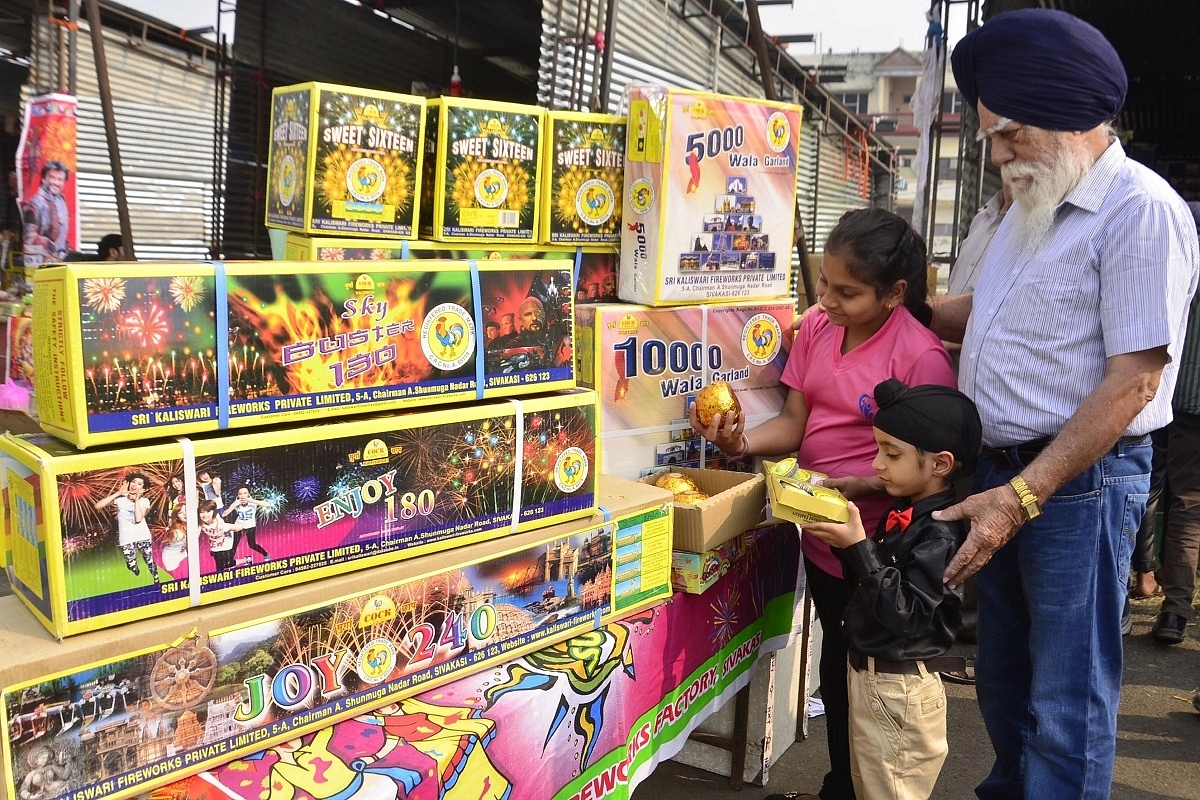Politics
It Was A Digital Diwali: DeMo Allowed Us To Spend More With Less Cash
- DeMo and digital payments have democratised money. Indians spent more this festive season, but used less cash than before.
- It was a happy digital Diwali for Indian producers and consumers.

Children buy firecrackers during Diwali in Amritsar. (Sameer Sehgal/Hindustan Times via GettyImages)
Some disruptive policy measures, even if initially damaging to the economy, tend to have positive fallouts years later.
The two big disruptions of the Narendra Modi government were demonetisation (DeMo, announced in November 2016), and the goods and services tax (GST) that was implemented barely eight months later in July 2017.
Both DeMo and GST hugely impacted the cash-based informal parts of the economy, an economy that was just recovering from two years of back-to-back droughts.
The pre-DeMo slowdown got accentuated and the economy was mugged again by Covid lockdowns and this year by the Russia-Ukraine war.
But surprise, the earlier disruptions have enabled us to handle the two more recent disruptions better than most parts of the world.
The Indian economy is the only one still in major growth mode and this is because of the two earlier disruptions.
During Covid, the economy’s steady shift to digital modes of payment was a godsend, as it enabled people to transact without cash when contact-based payments would have posed higher risks of contagion to the population.
The shift to digital payments in direct benefit transfers also enabled the fisc to provide support and subsidies to the targeted populations before, during and in the present Covid recovery phase.
In October, during the peak festival season, unified payments interface-based (UPI-based) transactions rose to 7.3 billion, valued at over Rs 12.11 lakh crore (ie, over Rs 12 trillion).
The Minister of State for Electronics and Information Technology, Rajeev Chandrasekhar, has said that India’s digital economy may be worth over $1 trillion in the next seven years. (Note: The digital economy, of course, relates not only to financial transactions. It includes everything from the production of mobile phones to 5G telecom services and digital services in general).
One of the reasons why the Modi government undertook DeMo was to reduce the usage of cash in day-to-day transactions, and this is what the huge success of UPI indicates.
The State Bank of India’s EcoWrap report, released on 3 November, suggests that for the first time in 20 years (barring 2009), the busy Diwali week saw a marginal decline of Rs 950 crore in currency in circulation (CIC).
Diwali is when almost all households, rich or poor, buy something, and if CIC has fallen, even marginally, it implies the widespread acceptance of digital payments among the general public.
Says SBI’s EcoWrap report: “A lower currency in circulation also is akin to a CRR (cash reserve ratio) cut for the banking system, as it results in less leakage of deposits and it will impact monetary transmission positively.”
This is because in a UPI transaction, money flows from the payer’s bank directly to the receiver’s bank, and thus remains as a bank deposit till withdrawn as cash. So, monetary policy can now be more effective.
The SBI report adds that bulk and large payments continue to be made through the National Electronic Funds Transfer (NEFT) system, which accounts for 55 per cent of transactions in value terms.
But “if we look only at transactions done through smart phones like UPI, IMPS (immediate payments system) and e-wallets (ie, prepaid money into wallets), they have share of around 16 per cent, 12 per cent and 1 per cent respectively.
"So, small retail payments done through UPI/e-wallets hold around 11-12 per cent in the payment industry.”
This implies two things: India is now a leader in the global digital payments game, and such payments have now penetrated deep down to the poorer segments of society. DeMo and digital payments have democratised money.
October GST revenues were the second highest ever at over Rs 1.52 lakh crore. Indians spent more this festive season, but used less cash than before. It was a happy digital Diwali for Indian producers and consumers.
Support Swarajya's 50 Ground Reports Project & Sponsor A Story
Every general election Swarajya does a 50 ground reports project.
Aimed only at serious readers and those who appreciate the nuances of political undercurrents, the project provides a sense of India's electoral landscape. As you know, these reports are produced after considerable investment of travel, time and effort on the ground.
This time too we've kicked off the project in style and have covered over 30 constituencies already. If you're someone who appreciates such work and have enjoyed our coverage please consider sponsoring a ground report for just Rs 2999 to Rs 19,999 - it goes a long way in helping us produce more quality reportage.
You can also back this project by becoming a subscriber for as little as Rs 999 - so do click on this links and choose a plan that suits you and back us.
Click below to contribute.
Latest